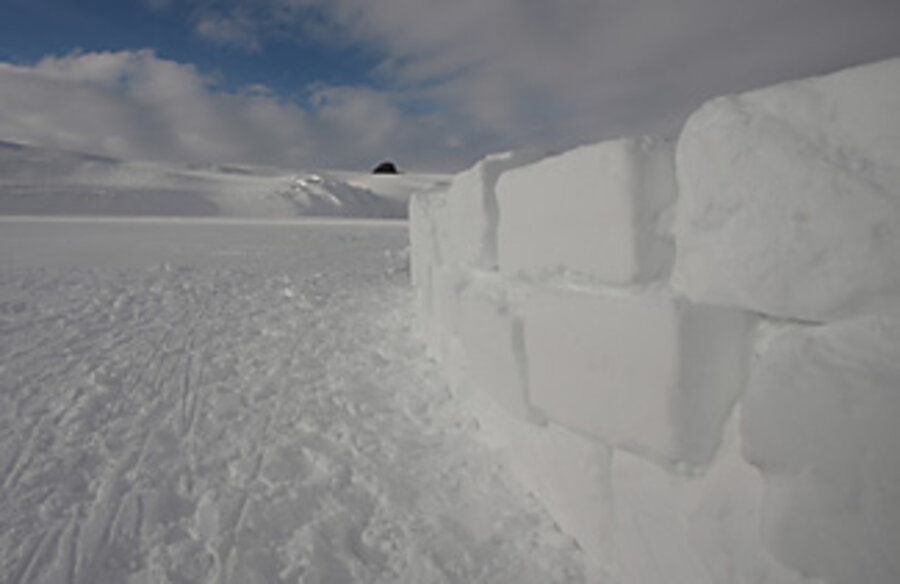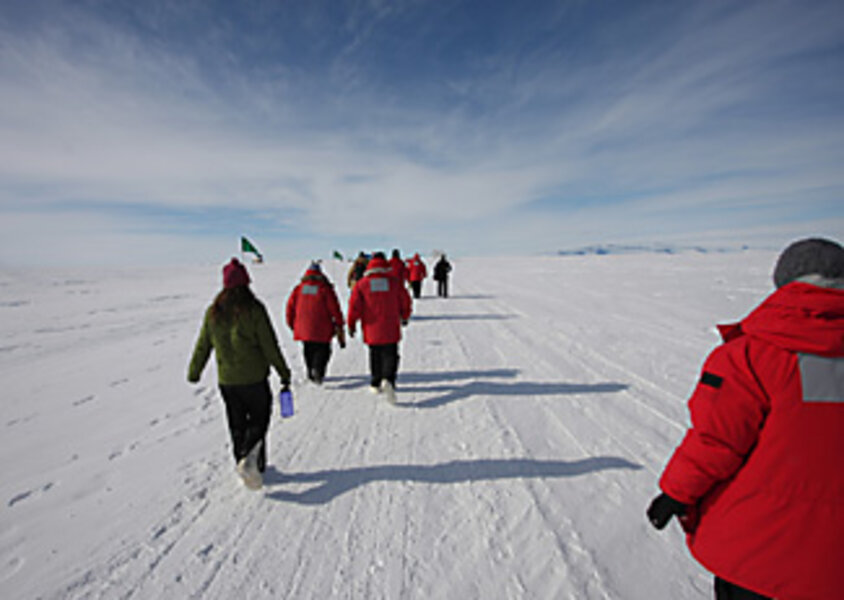Antarctica's required course is the Happy Camper School of survival
Loading...
| McMurdo Station, Antarctica
I nearly decapitate Ed as I heave a shovelful of snow over my shoulder. "Sorry," I say – again.
We're standing in a hole barely big enough for both of us, digging a snow cave called a quinzie, sort of a sunken igloo. We hope to sleep in this thing – but things don't look good: Four feet down we've hit a layer of compacted snow that repels shovels like Kevlar. This isn't the way you expect to spend one of your first nights in Antarctica, but here we are on a swath of ice the size of Rhode Island, learning to survive without so much as a tent for shelter. They call it Happy Camper School: a rite of passage for new arrivals at nearby McMurdo Station, the American research base on Antarctica's Ross Island.
A thousand souls populate McMurdo during the Austral summer from November to February – not just scientists, but also pilots, plumbers, burger flippers, and everyone else needed to keep a small city ticking. Down here, even a job like plumbing can transform into a survival epic in the blink of an eye. Just a few days before our mid-November class, a caterpillar-tracked truck caught fire while traveling on the sea ice. The passengers escaped the flames, but were stranded without shelter 15 miles from town. It's no wonder that anyone whose job might take them away from McMurdo must first attend Happy Camper School, a hands-on exercise in surviving overnight in one of the harshest spots on Earth.
Today's class includes 18 Happy Campers: among us a naturalist, a sheet metal worker, a self-identified computer geek, and six firefighters including Ed Asher, a heavy-armed, quiet-spoken former marine, and Angie Johnson, a wavy-haired Wisconsinite, also here as a firefighter, who introduced herself at the beginning of class with the simple comment, "I don't camp."
We're spending the night on the McMurdo Ice Shelf, a 600-foot-thick tongue of ice that oozes from Antarctica's coastal glaciers onto the Southern Ocean, sweeping around the southern rump of Ross Island. Somewhere far beneath our feet laps a layer of ocean water. The ice that we stand on drifts three feet per day on that water. The ice surface, sculpted by wind into the likeness of layered, Monument Valley sandstone, spreads toward an unbelievably flat horizon to the south and east.
Cold wind cuts through my fleece. I jab my shovel into the snow, pull on the parka that I'd shed earlier, and rub away the fog that has frozen onto my sunglasses. I hack away at the entrance tunnel of our quinzie.
• • •
Earlier this afternoon Galen Dossin and Kevin Emery, our two instructors, drove us to our campsite several miles from McMurdo. They immediately called our attention to the inviting spot several hundred yards away where the ice reclines gently off the hills of Ross Island.
"There are monster crevasses over there," warns Galen as he points out faint horizontal lines striping the hills. The unseen threat suddenly snaps into focus: Those telltale lines crisscross not only the hills, but also an area of flat ice that lies in front of the hills, much closer to us. Those crevasses have swallowed at least one McMurdo resident in recent years. Some gaps are hundreds of feet deep and hide beneath brittle crusts of snow.
Crevasses usually crack open where the ice flexes as it descends a mountainside or collides with another glacier, but isolated ones can lurk anywhere. They represent a constant, if unlikely, threat – an Antarctic equivalent to random urban violence. Here at our campsite, red and green flags on bamboo poles mark the only confirmed crevasse-free routes on the ice. Rows of these flags run in three directions from where we stand – plus a lone yellow flag in the distance, next to a patch of yellow snow.
"This snow is pretty amazing," says our instructor Kevin as he scree-scraws a carpenter saw through the edge of a snow pit. "If you want to build an igloo, this is the best place on earth." He makes three cuts with the saw, pries with a shovel, and a straight-edged block pops free. It works because Antarctica's high winds pack the snow so densely, compacting one layer of snow atop another, imparting it with naturally straight fracture lines. This sort of shovel-and-saw work forms the core of survival snow craft (shovels and saws are included in the survival bags that travelers are issued when they leave McMurdo). We'll assemble these blocks into a wall to block the wind and create a table for cooking freeze-dried meals on camping stoves. We'll also use stoves to melt snow for drinking water. It sounds simple, but there are right and wrong ways to do this.
"Don't burn the snow when you melt it," says Galen. Each snowflake contains a speck of dust around which it crystallizes, he explains, and if you cook snow directly on a stove rather than melting it in a pot of water, you singe the dust. "It actually tastes burnt."
Around 6 p.m. the instructors bid us farewell – "You're on your own until morning." As they walk toward a comfy-looking hut on the ice a half-mile away, each of us falls upon our chosen task. Some decide to play it safe and pitch tents. Others dig snow trenches three feet deep and just wide enough to lie down and sleep in. Someone calls them snow graves, and pretty soon Christian Angelici, an Italian naturalist and photographer, obliges by assembling snow blocks into a cross-shaped tombstone at the end of his. Another student carves a shelf into the wall of her trench for a water bottle and a paperback for bedtime.
The merriment stands in contrast to the situation with our quinzie. Angie and Todd Bevans, another firefighter, have shouldered much of the effort of digging it; Ed and I would be nowhere without them. But when I crawl in after two hours, I'm shocked that the chamber where four of us are supposed to sleep looks barely large enough for a medium-sized howler monkey. It's clear that despite our labors, not all can sleep here tonight. Angie and Todd set off to clean the snow drifts from another quinzie left by a previous Happy Camper class. Ed continues widening the inside of our own quinzie, kicking snow out the sunken entrance, which I heave away with a shovel.
By 9 p.m., the people who built snow trenches or went with the tried-and-true tent option have long since finished their work; the occasional shout drifts over from where they javelin-throw bamboo flags off in the distance. I crawl inside the quinzie to check on progress – this time, a pleasant surprise. Cool blue light seeps through the domed ceiling of snow. Ed has hollowed the chamber to accommodate two with room to spare.
When I finally crash in the quinzie sometime after midnight, the sun still dangles high in the summer sky, and Ed breathes quietly in his bag. As I thumb through a book of essays, I contemplate the pros and cons of lacing up my boots for a trip to the yellow flag, and weigh Kevin's endorsement of pee bottles ("I can't say enough about pee bottles," he'd instructed us. "I'm such a fan that I even have [one] in my room back in town").
It's the crunch of footsteps outside the quinzie that finally wakes me – 7:42 a.m., an hour late. Ed rolls in his sleeping bag on the far side of the chamber, dislodging a bit of snow from the ceiling inches above his head. "Pretty cozy," he croaks.
As I emerge from our warm Antarctic rabbit hole a cold wind surprises me – or perhaps the larger surprise is just how homey a snow shelter in Antarctica really can be.






